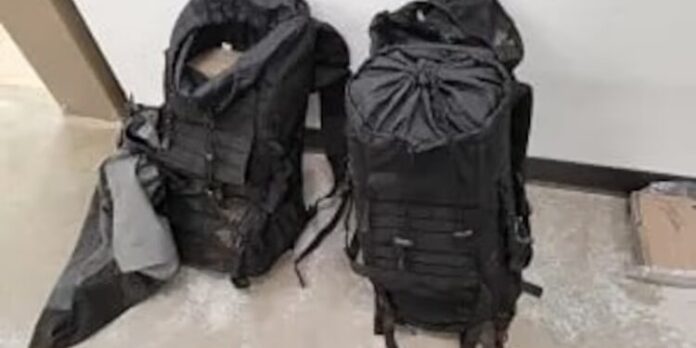In a dramatic operation near the Canadian border, United States Customs and Border Protection (CBP) agents have uncovered a cocaine stash estimated to be worth $1.1 million, hidden in two backpacks. This significant seizure occurred in the city of Lynden, Washington, approximately 110 miles north of Seattle. The discovery has raised concerns about ongoing drug smuggling efforts in the region.
According to a statement released by the CBP, the backpacks, weighing a total of 78 pounds, were found in a dense wooded area near the border. The bags, initially spotted by agents patrolling the Blaine Sector, were left abandoned on the ground. Upon closer inspection, the officers discovered 30 brick-like packages wrapped in plastic. These packages, upon testing, were confirmed to contain cocaine, a highly illegal substance with a street value of $1.1 million.
“Our dedicated agents remain vigilant every day to protect our communities from the dangers of illegal drugs,” said Chief Patrol Agent Rosario “Pete” Vasquez in a statement. “This successful seizure is a testament to the professionalism and commitment of our officers in safeguarding the country from harmful narcotics.”
The cocaine haul was immediately handed over to the Drug Enforcement Administration (DEA) for further investigation. While details about the ownership of the backpacks and how they ended up in the area remain scarce, authorities have not ruled out the possibility of an organized smuggling operation. The investigation is ongoing, with law enforcement agencies carefully examining all angles.
The area where the drugs were found lies within the Blaine Sector of the CBP’s jurisdiction, a known hotspot for drug trafficking due to its proximity to Canada. Over the years, law enforcement agencies have ramped up efforts to curb smuggling in the region, where drugs, firearms, and other contraband are frequently trafficked across the porous border.
“This is a significant win for our team, but it also serves as a reminder of the ongoing challenges we face in the fight against drug trafficking,” said Vasquez. “Each discovery like this brings us one step closer to shutting down the criminal organizations behind these smuggling operations.”
The backpacks, which were made of black material, stood out in the natural surroundings of the forested area, making them easier to spot by the keen-eyed agents. The immediate action taken by the CBP prevented the cocaine from entering local communities, where it could have caused further harm.
This event comes at a time when U.S. border patrol agents are on high alert following numerous drug-related incidents along the northern border. Smuggling attempts, particularly involving narcotics, have been steadily increasing in recent years, making it crucial for CBP and other agencies to remain vigilant.
In the past year, the U.S. government has stepped up efforts to combat the flow of illegal drugs across its borders, with a particular focus on halting cocaine, fentanyl, and other dangerous substances from entering the country. According to data from the DEA, cocaine seizures have been rising steadily, reflecting a growing trend in drug trafficking through both the southern and northern borders.
Despite these efforts, however, smugglers continue to employ new tactics to evade detection. From sophisticated hidden compartments in vehicles to remote drop-offs in uninhabited areas, criminal networks are constantly evolving their methods.
Authorities have not yet provided information on whether any arrests have been made in connection with the backpacks, and the investigation into the origin and intended destination of the cocaine remains ongoing. However, local law enforcement agencies have emphasized the importance of community involvement in reporting suspicious activities to assist in the fight against illegal drug trafficking.
As the investigation unfolds, border agents and the DEA continue to monitor the area for any signs of further smuggling attempts. The region, which shares a long and largely unguarded border with Canada, remains a hotbed for cross-border criminal activities.
While the discovery of this cocaine haul is a victory for border security, it underscores the persistent threat posed by drug cartels and traffickers seeking to exploit the vulnerabilities of border regions. Experts believe that stronger international collaboration between the U.S. and Canada is necessary to prevent future incidents of this nature and to dismantle the networks responsible for such illegal operations.
In Washington, the CBP has reassured the public that it remains committed to protecting the country from the flow of illegal drugs, a message reiterated by Vasquez. “We will continue our relentless efforts to stop drug traffickers at the border,” he said. “The fight is far from over, but each seizure like this one brings us closer to victory.”
Local residents in Lynden and surrounding communities have expressed their gratitude for the vigilance of CBP agents, recognizing the dangerous impact the narcotics could have had if they had made it past the border. With the seizure of the cocaine, many are hopeful that this victory will serve as a deterrent for future smuggling attempts in the area.
As authorities continue to investigate the source of the drugs, the outcome of this operation may have broader implications for future border security policies. With the rise in smuggling and the constant threat posed by criminal organizations, the U.S. government is expected to continue investing in enhanced security measures to combat the flow of illegal substances across the nation’s borders.
For now, the community of Lynden, Washington, can rest assured knowing that their border security remains in capable hands, with CBP agents working tirelessly to safeguard the region and prevent the illegal drug trade from reaching local streets.
“We’ve been able to make a significant impact today,” Vasquez concluded. “But we know there’s still much work to be done to ensure the safety of our communities.”

